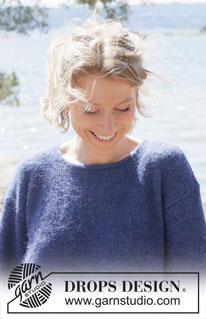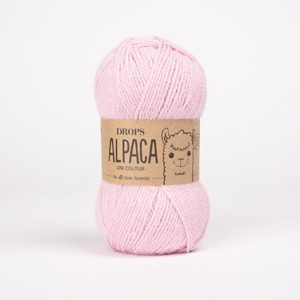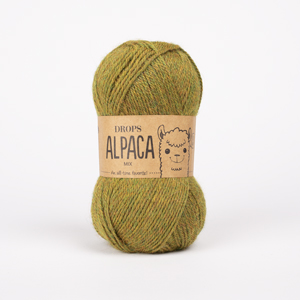Comments / Questions (13)
![]() Claudia wrote:
Claudia wrote:
Dann kann ich ja diesen Pullover mit zwei Fäden Baby Merino Stricken. Claudia
19.06.2025 - 12:03DROPS Design answered:
Liebe Claudia, ja sicher, die neue Garnmenge kalkulieren Sie mit dem Garnumrechner, hier. Viel Spaß beim Stricken!
19.06.2025 - 17:21
![]() Claudia wrote:
Claudia wrote:
Hallo liebes Drops Team Ich habe jetzt hintereinander gerechnet 300gr. Alpaca sind 287gr. Baby Merino. 100gr.KidSilk =229gr.Baby Merino. Könnt Ihr noch zurück schreiben ob dasokay ist. Liebe Grüße Claudia
19.06.2025 - 12:02
![]() Pia wrote:
Pia wrote:
Vad är vitsen med att sticka fram och tillbaka på rundsticka och sedan sy ihop istället för att sticka runt och slippa sömmen?
07.04.2025 - 09:23DROPS Design answered:
Hej Pia, det er for dem som synes om at strikke hvert stykke for sig og sy samme til sidst. Du gør hvad du synes bedst om :)
09.04.2025 - 15:09
![]() Rosanna Romagnoli wrote:
Rosanna Romagnoli wrote:
Salve a tutti! Ho appena scoperto questo sito e, non essendo affatto brava a navigare su internet, vedo che ci sono tantissime informazioni e guide, ma non trovo indicazioni sul numero di gomitoli da ordinare, in base alla taglia scelta. Mi aiutate, gentilmente? Vostra eterna ammiratrice, Rosanna
21.01.2025 - 22:35DROPS Design answered:
Buonasera Rosanna, in ogni modello, di fianco alla foto può trovare il materiale necessario per realizzare il capo. Buon lavoro!
21.01.2025 - 22:42
![]() Francis wrote:
Francis wrote:
De mindering voor de schouders van voor-en achterpand verschillen enorm. Daarnaast moet je de steken van de hals bij het achterpand afhechten en bij het voorpand laten staan en later weer opnemen, dit lijkt mij niet te kloppen
10.01.2025 - 23:20
![]() Estelle DUPLANTIER wrote:
Estelle DUPLANTIER wrote:
Bonjour, Existe t'il une méthode pour construire ce pull de manière circulaire en évitant les coutures finales ? Si oui, peut on l'obtenir ? Merci d'avance pour votre réponse. Cordialement, Estelle
26.12.2024 - 19:16DROPS Design answered:
Bonjour Mme Duplantier, vous pouvez additionner le nombre de mailles du dos et du devant en retirant les 4 m lisières et tricoter en rond, mais il vous faudra alors diviser en deux pour les emmanchures et terminer le dos et le devant séparément. Si vous préférez un pull sans couture, consultez nos modèles tricotés de haut en bas ici. Bon tricot!
02.01.2025 - 11:39
![]() Pascale wrote:
Pascale wrote:
Bonjour, Je suis en train de tricoter ce joli pull en taille M. En vérifiant la taille des manches, je constate que, sur votre patron, les mesures de celles-ci sont plus longues pour les plus petites tailles que pour les grandes (49 cm pour le S et 46 cm pour le XXXL). Y a-t-il une raison à cela ?
24.12.2024 - 17:30DROPS Design answered:
Bonjour Pascale, tout à fait, les manches sont plus courtes dans les grandes tailles car les épaules sont plus larges; vérifiez bien les mesures sur un vêtement similaire que vous avez et dont vous aimez la forme pour ajuster si besoin; notez que la largeur du dos/devant est de 45 cm en S et 62 cm en XXXL. Bon tricot!
02.01.2025 - 11:06
![]() Zuzana wrote:
Zuzana wrote:
Ďakujem za prehľadný zrozumiteľný návod. Pre niekoho môže byť užitočné, že pri veľkosti L mi zostalo jedno celé klbko DROPS ALPACA.
10.12.2024 - 21:36
![]() Heidi Goepen wrote:
Heidi Goepen wrote:
Ich würde gerne den Pullover Midnight-Meetup in der Farbe wie angezeigt, also in dem schönen blau stricken. Leider wird sie mir nicht angezeigt, um zu bestellen. Was kann ich machen? Danke für die Antwort
21.11.2024 - 13:24DROPS Design answered:
Liebe Frau Goepen, klicken Sie auf "Bestellen" für Alpaca/Kid-Silk, oder hier finden Sie die DROPS Händler sowie ihre Website, damit Sie Ihre Wolle bestellen können. Viel Spaß beim Stricken!
21.11.2024 - 16:07
![]() Quentin Cascales wrote:
Quentin Cascales wrote:
Avec quelle couleur d'alpaga faire correspondre Drops Kid-silk couleur cobalt? SVP merci
18.11.2024 - 14:40DROPS Design answered:
Bonjour Mr Cascales, pour toute assistance au choix d'une couleur, merci de bien vouloir contacter directement votre magasin DROPS, même par mail ou téléphone - retrouvez ses coordonnées dans la liste sur notre site ici. Bon tricot!
18.11.2024 - 16:20
Midnight Meetup#midnightmeetupsweater |
||||
 |
 |
|||
Knitted sweater in DROPS Alpaca and DROPS Kid-Silk. Piece is knitted bottom up, with sewn in sleeves and I-cord. Size: S - XXXL
DROPS 254-15 |
||||
|
---------------------------------------------------------- EXPLANATION FOR THE PATTERN: ---------------------------------------------------------- GARTER STITCH (when working back and forth): Knit on all rows, i.e. knit from right side and knit from wrong side. 1 ridge vertically = knit 2 rows. INCREASE TIP (applies to sleeve): All increases are done from the right side. Increase by making 1 yarn over inside 2 stitches in each side, on next row purl yarn over twisted to avoid holes. I-CORD BIND-OFF Slip the 3 new stitches from right needle to left needle so that working yarn is 3 stitches in on left needle (the working yarn tightens the piece when working to form a little tube). ROW 1 (= right side): Knit 2, knit the next 2 stitches twisted together. Slip the 3 stitches from right needle back on left needle, knit 2 together, knit the next 2 stitches twisted together. Do not turn piece. Repeat ROW 1 until 3 stitches remain on right needle. Slip the 3 stitches from right needle back on left needle. Bind off. Sew a little stitch that binds beginning/end of I-cord together. ---------------------------------------------------------- START THE PIECE HERE: ---------------------------------------------------------- SWEATER - SHORT OVERVIEW OF THE PIECE: In this pattern needles of different length have been used, begin with fitting length for number of stitches and switch as needed. Work piece back and forth on circular needle. Work front piece, back piece and sleeves separately. Piece is worked bottom up and parts are sewn together. Finish by picking up stitches around the neck and binding off with I-cord bind-off. BACK PIECE: Cast on 101-111-119-129-141-157 stitches on circular needle size 3.5 MM = US 4 with 1 strand DROPS Alpaca and 1 strand DROPS Kid-Silk. Work rib, begin from right side as follows: Work 1 edge stitch in GARTER STITCH - read explanation above, work rib (= knit 1/purl 1), until 2 stitches remain on row, knit 1 and finish with 1 edge stitch in garter stitch. Work until rib measures 5-5-5-6-6-7 cm = 2"-2"-2"-2⅜"-2⅜"-2¾", finish after a row from wrong side. Switch to circular needle size 5 MM = US 8, and work 1 row in stockinette stitch while AT THE SAME TIME decreasing 18-20-22-24-26-30 stitches evenly on first row = 83-91-97-105-115-127 stitches. Continue in stockinette stitch with 1 edge stitch in GARTER STITCH - read explanation above, in each side. Remember to follow the knitting gauge! When piece measures 37-38-39-40-41-42 cm = 14½"-15"-15¼"-15¾"-16⅛"-16½" bind off 3-5-6-7-8-11 stitches in each side for armholes = 77-81-85-91-99-105 stitches. Continue with stockinette stitch and 1 edge stitch in garter stitch in each side. When piece measures 54-56-58-60-62-64 cm = 21¼"-22"-22¾"-23⅝"-24⅜"-25¼", bind off the middle 27-29-29-31-31-33 stitches for neck and finish each shoulder separately. SHOULDER: Now bind off stitches for neck on every other row as follows: Bind off 1 stitch 1 time = 24-25-27-29-33-35 stitches remain on each shoulder. Bind off when piece measures 56-58-60-62-64-66 cm = 22"-22¾"-23⅝"-24⅜"-25¼"-26". FRONT PIECE: Cast on the same number of stitches and work as back piece until piece measures 50-52-53-55-56-58 cm = 19¾"-20½"-21"-21⅝"-22"-22¾". Now slip the middle 15-17-17-19-19-21 stitches on a thread for neck, and finish each shoulder separately. SHOULDER: Now bind off stitches for neck on every other row as follows: Bind off 2 stitches 2 times, and 1 stitch 3 times = 24-25-27-29-33-35 stitches remain on each shoulder. Bind off when piece measures 56-58-60-62-64-66 cm = 22"-22¾"-23⅝"-24⅜"-25¼"-26". SLEEVES: Work sleeves back and forth on needle. Cast on 56-58-60-64-66-66 stitches on circular needle size 3.5 MM = US 4 with 1 strand of each quality. Work rib as follows from right side: 1 stitch in GARTER STITCH - read explanation above, rib (= knit 1/purl 1), until 2 stitches remain, finish with knit 1 and 1 stitch in garter stitch. Continue rib like this for 5-5-5-6-6-7 cm = 2"-2"-2"-2⅜"-2⅜"-2¾". On next row from right side switch to circular needle size 5 MM = US 8 and knit 1 row while AT THE SAME TIME decreasing 10-10-10-12-12-12 stitches evenly on row = 46-48-50-52-54-54 stitches. Continue with stockinette stitch and 1 stitch in garter stitch in each side. When sleeve measures 12-13-11-13-15-15 cm = 4¾"-5⅛"-4⅜"-5⅛"-6"-6", increase in each side – read INCREASE TIP and increase as follows: Increase 1 stitch every 3½-3-3-2½-2-1½ cm = 1¼"-1⅛"-1⅛"-1"-¾"-½" 10-11-12-12-13-15 times in total = 66-70-74-76-80-84 stitches. Work until sleeve measures 47-47-46-44-43-40 cm = 18½"-18½"-18"-17¼"-17"-15¾". Insert 1 marker in each side of sleeve - these markers mark where bottom of armhole begins and are used when sewing the sleeve in the armhole. Work until sleeve measures 2-2-3-4-4-6 cm = ¾"-¾"-1⅛"-1½"-1½"-2⅜" from markers, sleeve measures approx. 49-49-49-48-47-46 cm = 19¼"-19¼"-19¼"-19"-18½"-18" from cast-on edge. Bind off. ASSEMBLY: Sew the shoulder seams. Sew sleeve seam up to marker. Sew sleeves to armhole, the vent on sleeve is sewn to the bottom of armhole - see chart. Sew side seams. NECK EDGE: Use circular needle size 5 MM = US 8 and 1 strand of each quality (= 2 strands), pick up stitches around the neck from right side as follows: Begin at one shoulder seam and pick up approx. 70 to 85 stitches (including stitches on thread mid front). At the end of round cast on 3 new stitches on right needle from right side, do not turn the piece. Bind off with I-CORD BIND-OFF - read explanation above. |
||||
Diagram explanations |
||||
|
||||

|
||||

|
||||
Have you finished this pattern?Tag your pictures with #dropspattern #midnightmeetupsweater or submit them to the #dropsfan gallery. Do you need help with this pattern?You'll find 31 tutorial videos, a Comments/Questions area and more by visiting the pattern on garnstudio.com. © 1982-2025 DROPS Design A/S. We reserve all rights. This document, including all its sub-sections, has copyrights. Read more about what you can do with our patterns at the bottom of each pattern on our site. |
||||
















































































Post a comment to pattern DROPS 254-15
We would love to hear what you have to say about this pattern!
If you want to leave a question, please make sure you select the correct category in the form below, to speed up the answering process. Required fields are marked *.